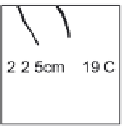Agriculture Reference
In-Depth Information
them. Too much heat will prompt them to bolt early, so if you're growing for
leaves, give them a little shade on warm days or plant them between other taller
plants. They don't usually need feeding when grown in reasonable soil.
Harvesting and storage
To extend the harvest, bolting can be delayed by not letting coriander get too
many leaves. Pick it frequently, as for lettuce. Alternatively, cut the top third off
the stems, leaving the bottom two-thirds to grow again. Pick off any flowers as
soon as you see them to keep the energy going into leaf growth.
When you eventually lift the plant, the root can be used as a flavouring for soups
and sauces. Cut it with 2cm of greens still attached and wash it well before storing
in a plastic bag in the fridge for up to one week, and bruise it with a pestle and
mortar before adding it whole to your cooking.
Growing coriander seed for culinary use in the polytunnel is less practical than
doing so outside because if given free range the bolting plant tends to sprawl,
and the seeds take a long time to mature. Growing one or two plants to save seed
is a different matter. These should be given full sun, and their fragrance will
quickly become a favourite part of your daily tunnel visits.
Coriander leaves lose their flavour when dried, but can be frozen in small bunches
to be crumbled into cooking straight from the freezer. Resist the urge to rinse
them before freezing, as the taste suffers.
Problems
Aphids
.
Courgette (zucchini)
Varieties:
'Green Bush', 'Defender' (F1), 'Verde di Milano'
There are two types of courgette: 'bush' and 'trailing'. Bush is the best type to
grow in a polytunnel as the trailing type will tend to invade the space you want
to give to other plants.
Tunnel courgettes produce earlier than those outdoors by two to four weeks,
and will continue to produce a harvest for a month or more after the ones outside

























































































